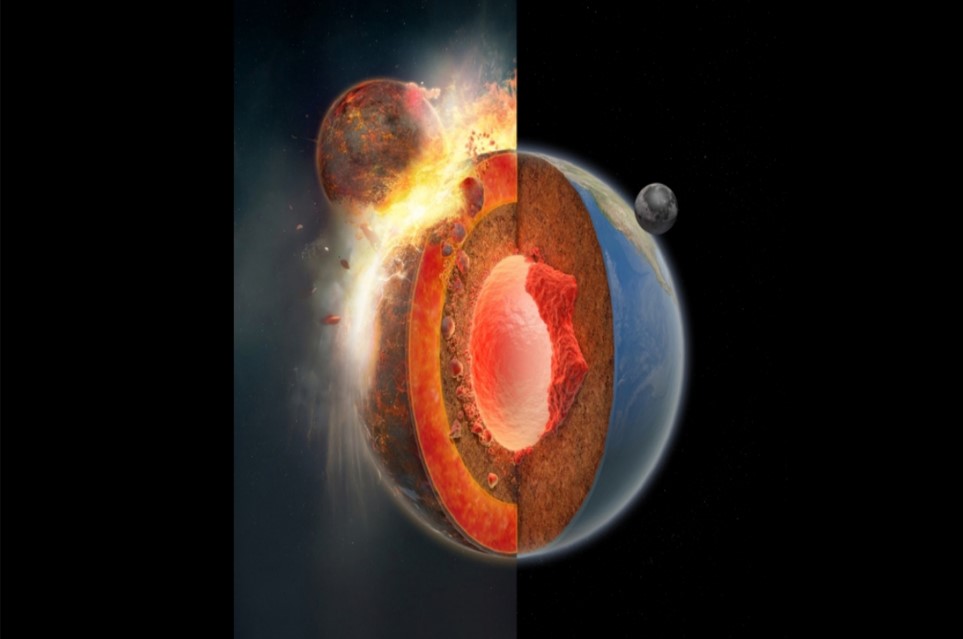Earth's Two Giant Blobs: Likely Shape Shifters Below the Surface
Beneath Africa and the Pacific Ocean lie two immense blobs, each the size of a continent, extending nearly halfway to the Earth's core. These blobs, which occupy a significant portion of the Earth's volume, serve as the source of deep mantle plumes—rising columns of hot rock that trigger colossal volcanic eruptions upon reaching the surface. These eruptions, akin to those that led to the demise of dinosaurs millions of years ago, shape our planet's geological landscape. Moreover, the blobs likely influence the eruption of kimberlite, a rock type responsible for bringing diamonds from depths of up to 800 km to the Earth's surface. While scientists have long known about these blobs, their behavior over Earth's history remained elusive until recently. New research, modeling a billion years of geological evolution, reveals that these blobs undergo cycles of gathering and dispersing, akin to the movements of continents and supercontinents, shedding light on their dynamic role in shaping Earth's geological processes.[1] Figure 1 shows Illustration: Accumulation of Theia Remnants Forming Large Low-Velocity Provinces (LLVPs) in Earth's Mantle.

Figure 1. Illustration: Accumulation of Theia Remnants Forming Large Low-Velocity Provinces (LLVPs) in Earth's Mantle
Modelling the Evolution of Earth's Enigmatic Blobs
The blobs reside within the mantle, the dense layer of hot rock sandwiched between Earth's crust and core. Although the mantle is solid, it exhibits slow flow over extended periods. The presence of the blobs is discernible because they impede the propagation of seismic waves generated by earthquakes, indicating that they are hotter than the surrounding material.
The relationship between Earth's enigmatic mantle blobs and the movement of tectonic plates has long intrigued scientists, yet understanding their evolution over geological time has remained elusive. While some theories proposed that these blobs have remained relatively stationary, serving as fixed anchors amid shifting tectonic activity, recent research suggests otherwise. Advanced computer simulations conducted using Australia's National Computational Infrastructure reveal that over the course of a billion years, Earth's mantle has undergone significant changes, with the blobs exhibiting a dynamic history akin to the assembly and breakup of continents and supercontinents on the Earth's surface.
These simulations, which incorporate the movements of tectonic plates, demonstrate that when plates converge and undergo subduction, pushing oceanic rock into the mantle, the blobs are displaced. They can coalesce into "superblobs" or disperse over time. Notably, despite their shifting positions and morphologies, the blobs still align with the patterns of volcanic and kimberlite eruptions observed on Earth's surface. These finding challenges previous notions of the blobs as static features and suggests a more dynamic role in Earth's geological processes.
One striking revelation from the models is that the African blob, for example, formed as recently as 60 million years ago, contradicting previous assumptions of its long-standing stability. This newfound understanding sheds light on the dynamic nature of Earth's mantle and its profound impact on the planet's surface features and geological phenomena.
Outstanding Queries Concerning Earth's Enigmatic Mantle Blobs
How did the blobs originate? What exactly are they made of? We still don't know.
The blobs might be denser than the surrounding mantle, potentially composed of material that segregated from the rest of the mantle during Earth's early history. This deviation could account for the discrepancy in Earth's mineral composition compared to models based on meteorite composition.
Alternatively, the density of these blobs could be due to the accumulation of dense oceanic material from rock slabs pushed down by tectonic plate movement.
Regardless of this ongoing debate, our research indicates that sinking slabs are more inclined to carry continental fragments to the African blob rather than to the Pacific one. Interestingly, this finding aligns with recent studies suggesting that mantle plumes originating from the African blob contain continental material, while those from the Pacific blob do not.
Exploring Blobs for Mineral and Diamond Deposits
While our research delves into fundamental inquiries about Earth's evolution, it also holds practical implications.
Our models offer a structured approach to pinpointing the whereabouts of minerals linked with mantle upwelling. This encompasses diamonds brought to the surface via kimberlites, which appear to have an association with the blobs.
Moreover, magmatic sulphide deposits, serving as the world's primary nickel reserves, are correlated with mantle plumes. By aiding in the targeting of minerals like nickel (crucial for lithium-ion batteries and other renewable energy technologies), our models can play a role in advancing the transition to a low-emission economy.[2]
References:
- https://www.geologyin.com/2023/06/two-giant-blobs-lurk-deep-inside-earth.html
- https://theconversation.com/volcanoes-diamonds-and-blobs-a-billion-year-history-of-earths-interior-shows-its-more-mobile-than-we-thought-179673
Cite this article:
Gokila G (2024), Earth's Two Giant Blobs: Likely Shape Shifters Below the Surface, Anatechmaz,pp. 947

